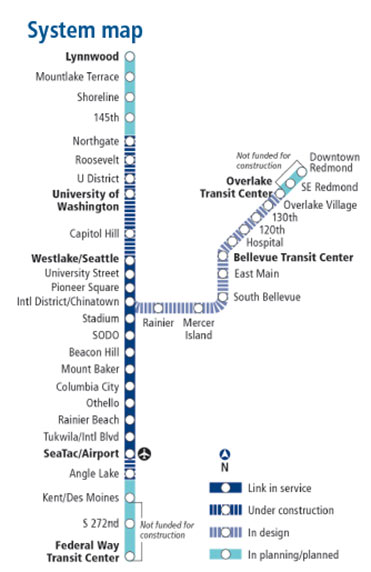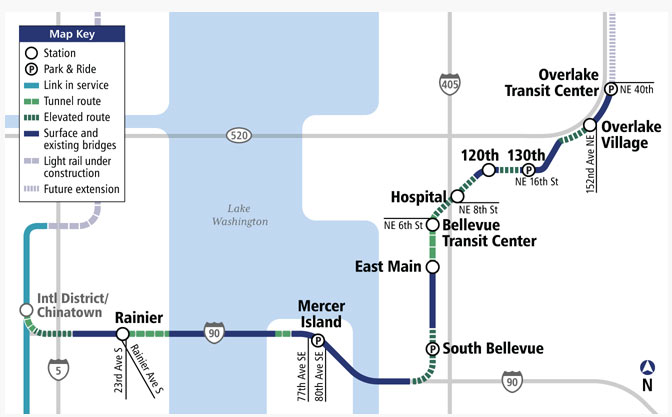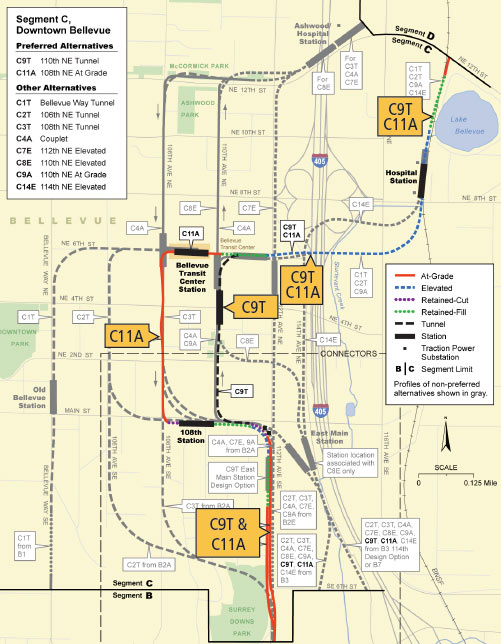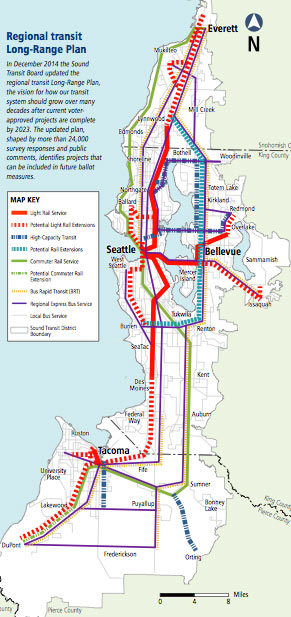Seattle advances its LRT ambitions 2 June 2015
Light rail transit construction and future planning is moving full steam ahead on three fronts in Seattle. The city’s newest LRT underground line, University Link, is substantially complete; the all-underground extension of the line further north to Northgate is well into construction; and advanced design of the East Link extension from Chinatown eastwards across Lake Washington to Overlake, via a new tunnel in Downtown Bellevue, is complete.
East Link
Scheduled for opening in 2023, the 14-mile long US$3.6 billion East Link builds on the Central Link light rail system running between Sea-Tac Airport and Downtown Seattle, and the underground University Link (Chinatown–Westlake) and South 200th Link Extensions (elevated section to the south of Sea-Tac Airport) that are scheduled to open for service next year (2016).
Contractors appointed by Sound Transit have already begun utility relocations in advance of an East Link procurement process that is already under way ready for a scheduled construction start next year (2016). The very first contract to be let will be the cut-and-cover tunnel under 110th Avenue in Downtown Bellevue, which emerged as the preferred choice from 10 options presented by Sound Transit in the 2011 Final Environmental Impact Statement. Alternatives for the Downtown Bellevue tunnel section included both at grade and elevated solutions, as well as alternative tunnel alignments. Bids in the region of $130-180 million are expected.
Work for the CN0148-14 contract, which forms the central part of Segment C the alignment, will begin with preparing the south portal staging area, including demolition of existing structures and the existing portion of SE 1st Place. Site work will include grading and utility relocation, replacement, and demolition.
Project scope also includes installation of a temporary construction sound wall around the south portal area prior to heavy civil work, including excavation and construction of retaining walls and the portal box structure. Work will include approximately 585ft of soil nail wall support of excavation system, and 325ft of a permanent soil nail wall system.
Tunneling operations are anticipated to be staged primarily from the south portal and include approximately 1,985ft of tunnel construction using the Sequential Excavation Method (SEM) or New Austrian Tunneling Method (NATM). This will include, but not be limited to, tunnel pre-support, ground water control, waterproofing, final lining, tunnel walkway, center dividing wall, and embeds and conduits. A mid-tunnel access shaft and adit will be constructed also using SEM/NATM.
At grade ground improvements above the northern 125ft of tunnel includes excavation and installation approximately 10ft of a controlled low-strength material for the width of 110th Avenue NE. The northern limit of the tunnel contract is the headwall of the north portal structure.
Invitations to bid have already been issued, with bids due by August (2015), ahead of contract award and notice to proceed being issued in November. The construction schedule specifies construction completion of the Bellevue Tunnel by May 2020.
Further east, the alignment connects to Downtown Seattle using the I-90 highway floating bridge across Lake Washington. There are already agreements in place between Sound Transit and the Washington State Department for Transportation (WSDOT) that will enable the centre lanes of the bridge to be used for LRT, though Sound Transit will be paying to widen the bridge to accommodate extra traffic lanes. Ahead of the bridge, the LRT will run through Seattle's Mount Baker tunnel on lanes that are used today for contra flow rush-hour traffic, but which were included in the tunnel's original design and construction for future light rail services.
Northgate Link
Construction of the 5.5km all underground Northgate Link, which extends further north the substantially complete University Link, continues on schedule. Two refurbished machines are being used to complete the parallel drives – a 6.65m diameter Robbins EPBM and a Hitachi Zosen machine that was used by the same contractor (JayDee/Collucio/Michaels) as one of the four machines used to excavate the University Link.
The challenging schedule of a 2021 service opening for the Northgate Link remains on track. Kimberley Reason, for Sound Transit, told TunnelTalk this week: “TBM1 launched from the Maple Leaf portal at the northern end of the alignment in July 2014, achieving breakthrough at Roosevelt Station only last month [May 2015]. It is now back in the ground and is scheduled for arrival at U-District Station [Brooklyn on the map] in the fall, and final breakthrough at University of Washington Station in spring 2016.
“TBM 2 launched in November 2015 and is expected to arrive at Roosevelt Station this summer, U-District Station in late 2015, and University of Washington Station mid-2016,” said Reason. “Crews are currently excavating the station box for U-District Station, where excavation is 90 percent complete and will continue through the summer.”
University Link
Initial testing of the 3.15km U-Link line between downtown Seattle and the University of Washington should commence before the end of the year (2015), with Sound Transit reporting the US$1.95 billion project expected to come in $150 million under budget. The line is scheduled to enter into service six months ahead of schedule in early 2016, and possibly even later this year.
TBM excavation wrapped up four months early in July 2012, and all 16 NATM/SEM cross passages are also completed and lined. University of Washington Station is finished, and just 9 percent of construction work remains on Capitol Hill Station, with systems and track installation running currently to 82 percent completion.
2023 and beyond – ST3 ballot
All the projects listed above are part of the so-called Sound Transit 2 (ST2) ballot measure – projects selected from a range of options presented to, and approved, by Seattle residents in 2008.
Preparations are currently under way by Sound Transit transportation planners for the next wave of projects that will form ST3 – which could be ready for voter consideration as early as November 2016. Projects that make the list for ST3 will take the city beyond 2023, at which time all ST2 measures, including East Link, are expected to be delivered into service or already be in service.
ST3 will expand light rail services further and deeper into King, Snohomish and Pierce counties to meet increasing demand for predictable and reliable mass transit services in an area where more than 40 percent of Washington residents live and where 70 percent of the State’s economic activity takes place.
A process of local-level consultations has already started, but it appears that this time it appears that projects that will not involve significant underground construction are favoured. Hopes for an LRT connection between Ballard and Downtown Seattle by way of a US$2.5–3 billion undercrossing of Salmon Bay, and further tunnelling under the Queen Anne district appear to have been dashed.
Bruce Gray, for Sound Transit, told TunnelTalk: “Right now there are no major tunnels in the initial plans that may be put up for a vote to expand the system but we are still working out what the project list would entail. This month (June 2015) we will host a series of meetings and solicit feedback online about what voters’ priorities are based on the initial planning that we have done.
“The Board selects which projects from the Long Range Plan to include in each expansion vote. For Sound Transit 3, the Board has indicated it wants to ‘complete the spine’ of rail from our current north terminus in Lynnwood to Everett; and from our current south terminus all the way to Tacoma.”
References
- Planning a third wave of Seattle LRT – TunnelTalk, July 2013
- Sound Transit Downtown Bellevue Tunnel procurement – TunnelTalk Procurement,
Northgate Link
- Robbins EPBM away for Seattle Northgate – TunnelTalk, January 2015
- Seattle Northgate bid result – TunnelTalk, May 2013
- Construction management for Northgate LRT – TunnelTalk, November 2012
- Seattle Northgate bid result – TunnelTalk, May 2013
- Seattle Northgate Link TBM dedication – TunnelCast, Apr 2014
University Link
- U-Link on track to open six months early – TunnelTalk, November 2013
- TBMs wrap up early on Seattle U-Link – TunnelTalk, August 2012
- Success in Seattle as TBM holes through – TunnelTalk, March 2012
- U-Link TBM breakthroughs – TunnelTalk, November 2011
- TBMs launched on Seattle’s U-Link – TunnelTalk, May 2011
- U-Link prepares to receive its TBMs – TunnelTalk, March 2011
- Mobilization of Seattle’s U-Link extension – TunnelTalk, July 2010
East Link
- Seattle LRT breakthroughs – TunnelTalk, November 2011
- Seattle selects East Link route – TunnelTalk, August 2011
- Build out plans for Seattle LRT – TunnelTalk, July 2010
|
|
|
|
|
Add your comment
- Thank you for taking the time to share your thoughts and comments. You share in the wider tunnelling community, so please keep your comments smart and civil. Don't attack other readers personally, and keep your language professional.







